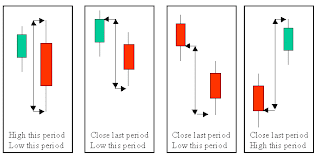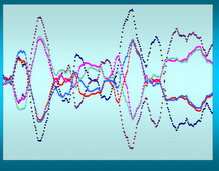The true range is finding the lowest of either the low of this period or the close of the last period and subtracting that from whichever is higher - the high of this period or the close of the last period. Here are some diagrams of what that might look like.

And here is a display using INDU. Note in this figure that true range (tr) ‘a’ uses the close from 2/26 and the low from 2/27 and that ‘b’ uses the high and low from a single day. Note that the Average True Range is an exponential average.

So, why is the ATR important to traders? Because as is pointed out in this Wikipedia article the ATR measures volatility. And volatility is a "tell" regarding future market direction.
I noticed some time ago that when the ATR on the Dow Industrial average dipped below 80 the market was due for a decline - not immediately but within a couple of days. That would be followed by an ATR spike when the market started going down and then the market would resume going up once the spike was done and had rolled over and went back down again. You have to understand it isn’t that the ATR is doing anything, it is the Industrial’s price that is doing all of the work. The range from period to period or within the period is what constitutes the true range – the ATR just makes price volatility that much more visible. One thing I do want to point out though - the '80' figure that I used above will not necessarily hold for all market periods - you have to be observant and watch for what works or doesn't.
Here is a one-year figure showing this relationship between spike and drop and return to normal.

Here it is over two years.

And, finally, three years on a weekly basis – note that the value has changed which makes sense because this is a weekly view but that the effect remains the same. The notes on this chart are also important.

The ATR can be used on a variety of time frames but the length might need to be varied to take into consideration the time period being used. I.E. you will have to experiment to find what works for you.
And just as important is the following - This is not a correlation to the absolute. If everything were correlated to “1” there would be no room for error. Without error we could not learn. And without learning we can not grow - Marlyn Trades

6 comments:
Great stuff. Thanks for the writeup.
What a great correlation. Using this in conjunction with RSI can provide excellent swing points.
Hi ,
I love your blog. It's actually one of my favorite right now, and i hope you will continue it this way, because your vision of the market is the kind i like to read about, and to think about.
Cheers
Nicholas.
Something subtle for everyone to consider. Is the ATR formula in any software/website you're using calculated via MA, EMA or Wilder's EMA? Most programmers aren't astute enough to realize Wilder's EMA is NOT the standard EMA.
The standard EMA equivalent to Wilders EMA is Period=(2*Wilders)-1, so ATR(2) using EMA is NOT the same as ATR(2) using Wilder's EMA -- thus, it is LAGGIER. The same truism holds for RSI. For a long time, TradeStation infamously had a problem of calculating RSI with the standard EMA which gave inconsistent results with other software comparisons. AmiBroker is one charting/backtesting/filtering software that has the correct Wilder's formulas as well as a Wilder's EMA to use in general.
To emphasize: ALL OF WILDER'S INDICATORS WERE DESIGNED USING WILDER'S EMA NOT THE STANDARD EMA.
I note that Marilyn once said its better to smooth a MA with a MA, but ATR does not use a MA. So to be consistent, you should smooth the 10-period ATR with Wilder's EMA or standard EMA if its the aborted version.
MachineGhost
I've just recently downloaded Mt4 Protect and wanted to tell you guys about my experience with it.
I was worried about all the MT4 Malware out there at the moment as I heard you can get them from downloading Expert Advisors from the web.
While I don't download decompiled forex robots the last thing I want is some hacker getting my account details and draining my trading account as I have built it up into quite a bit of cash. That's why I purchased MT4 protect so it can stop my account from getting attacked. I think the price is well worth the protection I will receive
I bought a copy at [url=http://www.mt4protect.com/] http://www.mt4protect.com/ [/url] via paypal and my product code was sent to me within 4 hours.
I installed it and its wicked! It works in the system tray and scans my computer in real time to detect any attacks.
The EA optimization tool is so great - you can allocate more memory to your MT4 terminal so your trades get executed faster! There are also heaps of registry tweaks and cleanup features that have tuned up my Windows XP computer.
With malware and virus attacks hitting Forex traders all the time now I definitely think that MT4 Protect is a worthwhile investment.
Colorful charts
Post a Comment